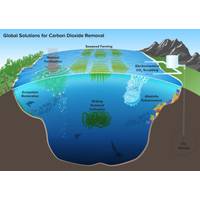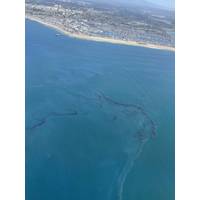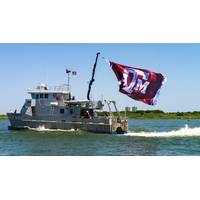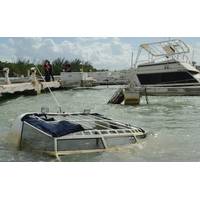
Carbon Dioxide Removal (CDR) ... To Clear the Air, Look Beneath the Waves
in terms of its impact on marine life and carbon sequestration,” explained Salvador Garcia, chief revenue officer. Nitrogen and phosphorus play especially crucial roles, stimulating the primary production of the phytoplankton that absorb CO2 in the oceans.Inspired by the events of Hurricane Katrina, company founder and CEO Philip Kithil was moved to design a wave-powered ocean pump to cool the ocean’s surface and in turn, lower the intensity of hurricanes. Coincidentally, this process also simulated artificial upwelling, and subsequent research by the University of Hawai’i and

'Catastrophic' California Offshore Oil Spill Kills Fish, Damages Wetlands
. It's well past time to prevent future oil spills by permanently protecting our coasts from offshore drilling."The spill occurred in federal waters. Officials said federal, state and city agencies were involved in a response headed by the U.S. Coast Guard.On Sunday, Orange County supervisor Katrina Foley said the oil had infiltrated the Talbert Marsh, a large ecological reserve, causing "significant damage."Beaches were closed to swimming and a local air show was canceled, although some people were undeterred from setting up chairs on the beach to enjoy a sunny Sunday or strolling

Texas A&M Introduces Master of Science in Ocean Engineering Program
disaster research.“I’ve always been interested in the environment and, in particular, things like hurricanes and natural phenomenon like El Niño,” said Humphrey. “I grew up in Florida, so I’ve experienced hurricanes quite a bit. My family went through Hurricanes Katrina and Irma. And then I came here and went through Hurricane Laura. These are incredible natural phenomenon, and we cannot avoid them. And, as climate change continues to increase, they are becoming more prevalent and stronger.”Humphrey explained that a background in ocean engineering would give

University of Miami’s Hurricane Research is Helping Save Lives
intensityAlthough the high winds and heavy rain from hurricanes are dangerous, it is the storm surges – a rise in sea level caused by hurricane intensity and the strong winds of the hurricane pushing seawater onshore – that pose the greatest threat to property and human lives. When Hurricane Katrina hit land in 2005, over 1500 people lost their lives to the storm surges, which reached up to 26 feet (8 meters) above normal sea level.In the same year, Hurricane Wilma surprised everybody when it powered up from a Category 2 to a Category 5 hurricane in a matter of hours.Then when Hurricane Irma
Harvey, Irma, Maria and Nate Retired
. 25. The storm then stalled, with its center remaining over or near the Texas coast for four days, dropping historic rainfall amounts, of up to five feet, causing catastrophic flooding in parts of southeastern Texas. Harvey is the second costliest hurricane in U.S. history (after inflation), behind only Katrina in 2005. At least 68 people died from the direct effects of the storm in Texas, the largest number in that state since 1919. Hurricane Irma was a long-lived hurricane that reached category 5 intensity on Sept. 5. The catastrophic hurricane made seven landfalls, four of which occurred as a category

NOAA Taps Graham to Lead National Hurricane Center
for hurricanes Gustav, Ike, Isaac, and during the historic 2017 season. Prior to leading the New Orleans/Baton Rouge forecast office, Graham served as the systems operations division chief at National Weather Service Southern Region headquarters in Fort Worth, Texas, where he led Hurricane Katrina recovery efforts. He also served as the meteorological service chief at NWS headquarters in Silver Spring, Maryland, and was the meteorologist-in-charge at the local forecast offices in Birmingham, Alabama, and Corpus Christi, Texas. Graham has vast experience working with emergency managers

Weather Disasters Cost US $306 Bln in 2017 -NOAA
casts doubts on the causes of it and has started withdrawing the U.S. from a global pact to combat it. NOAA said western wildfires and hurricanes Harvey, Maria, and Irma contributed to making 2017 the costliest year on record. The previous record was $215 billion in 2005, when hurricanes Katrina, Wilma, and Rita slammed the U.S. Gulf Coast. Average annual temperatures for the contiguous United States were 54.6 degrees Fahrenheit (12.6 degrees Celsius), 2.6 degrees Fahrenheit above the 20th century average and the third warmest since recordkeeping began in 1895, following 2012 and
Gulf Coast Coastal Restoration Work Awarded
dredging, environmental and remediation services, has received an $88 million award for Phase I of the Mississippi Coastal Improvements Program (MsCIP) Comprehensive Barrier Island Restoration. MsCIP was initiated in 2005 in the aftermath of the damage and destruction caused by Hurricane Katrina, and addresses hurricane and storm damage reduction, salt water intrusion, shoreline erosion and fish and wildlife preservation. Ship Island is part of the Gulf Islands National Seashore and currently exists as two island segments, East Ship and West Ship, separated by Camille Cut. In 1969

We [Heart] Actinobacteria
, however, the rhodopsin almost certainly does more—converting the light into energy. (Those findings were recently published in the International Society for Microbial Ecology Journal.) In a 2014-16 funded project with Wisconsin Sea Grant, McMahon and UW-Madison structural biologist Katrina Forest took it further, revealing something even more surprising about freshwater actinobacteria. “Actinobacteria have the retinal found in most opsin proteins that allows them to harvest light, but we think they also have another light-harvesting structural molecule that allows



 February 2024
February 2024





